|
MVP
OVR: 20
Join Date: Apr 2003
Location: Downtown Chi-Town
Posts: 4,175
|
Official Custom Tactics thread
I will also be posting this in the Custom team Tactics thread. ....Supporting photos on the way shortly....
Custom Tactics
Custom Tactics is one of the biggest additions to the Fifa franchise this year. Eleven different settings can be adjusted to control how the team plays. This includes how the team passes, moves, positions and creates scoring chances. Now teams like Arsenal will zip the ball around the field with short passes, while teams like Celtic will bomb the ball forward and try to attack via Route 1.
There are two components to the Custom Tactics. The CPU both positions players and executes based on the team’s Custom Tactics settings. For Human controlled players, the Custom Tactics settings influence the way the other nine field players move in relation to the player that you are controlling.
In this section of the guide, we will explore the different settings available for Fifa 09 and then take them on the pitch to show you how they impact gameplay.
Build Up Play
There are three Build Up settings in the game: Speed, Passing, and Positioning. Build Up settings affect how your team will play in the first two-thirds of the pitch. The CPU will execute passes based on these settings. Your players will position themselves based on these settings. It is still up to you to make the correct passes. Build Up settings mostly affect the Central Midfielders, Wing Defenders and Outside Midfielders.
- Speed – Build Up speed determines the speed at which the attacking team advances play in the first two thirds of the pitch. This not only changes the emphasis on Forward, Lateral, or Negative play, but also alters the urgency that teammates have getting into forward positions.
- Slow – The team is patient building plays, often passing the ball around in defence with players regularly passing backwards. Players are more selective in their runs going forward, and put the emphasis on finding good space over finding forward space.
- Balanced – The team does not build play particularly fast or slow.
- Fast – The team looks to get the ball from back to front as quickly as possible. Players choose to position themselves in more advanced positions on the pitch. Players make more forward runs.
- Passing – Build Up Passing Distance determines the general passing direction, and the style of support play from teammates in the first two thirds of the pitch. This changes the emphasis on long or short passes both on and off the ball.
- Short – The team will try to build using short passes. Players closest to the ball will come to support.
- Mixed – the team does not build using a particularly short or long passing game.
- Long – the team will look to play the longer ball, perhaps targeting a tall striker or looking for a ball over the top. Players farther from the ball possessor will attempt to find space. Close players will anticipate the long ball and push up to look for the knock down or flick on.
- Positioning – Build Up Positioning determines the freedom that players have to make runs, and support in positions that stray from their formation position in the first two thirds of the pitch.
- Organized – Players tend not to stray too far from their assigned positions during the course of the match. The team maintains structure when building play.
- Free Form – Players have the freedom to make runs out of position. For example, forwards can make more runs wide to collect the ball, fullbacks can make more overlapping runs, wide players can cut in more, and central midfielders can make runs to the corner or overlap the strikers.
- How It Works on the Field
Short Passing
In a short passing system, you will see more “check to” runs by players as they drop back into space to receive the ball. The team will arrange itself in such a way that there are multiple short passing options available. Ultimately, you control when and where you pass, but the CPU will position your support players in good position to maintain possession.
When our defender receives the ball (highlighted in yellow), notice how many red highlighted targets he has. This is the advantage of the short passing system. You typically have multiple options for the dribbler.
 Long Passing
In a long passing system, players will make anticipatory runs and look for knockdowns from Target players. Opposite wingers will make runs looking for the big switch. Strikers will either make get behind runs, or check back to receive long passes from the defence.
Long Passing
In a long passing system, players will make anticipatory runs and look for knockdowns from Target players. Opposite wingers will make runs looking for the big switch. Strikers will either make get behind runs, or check back to receive long passes from the defence.
 Notice with this Long passing team that the nearest open player is 30 yards or so down the field. This is pretty typical of teams set to use a Long Passing tactic.
When playing against highly aggressive pressing teams, you will want to set up the long ball to take advantage of their defensive attitude. If you use a long passing team, you’ll need to be comfortable with looking at your Radar while playing so you can pick out deep players
Notice with this Long passing team that the nearest open player is 30 yards or so down the field. This is pretty typical of teams set to use a Long Passing tactic.
When playing against highly aggressive pressing teams, you will want to set up the long ball to take advantage of their defensive attitude. If you use a long passing team, you’ll need to be comfortable with looking at your Radar while playing so you can pick out deep players
 We receive the ball in the center circle, and you can already see that our winger is calling for the ball.
We receive the ball in the center circle, and you can already see that our winger is calling for the ball.
 We hit a throughball to get the ball to him on a dead sprint.
We hit a throughball to get the ball to him on a dead sprint.
 His “get behind” run does the trick and he is free to go one-on-on with the keeper.
Slow Build Up
Teams with Slow Build Up Speed settings will drop back more into support positions. The emphasis is on keeping control of the ball rather than advancing it down the field.
His “get behind” run does the trick and he is free to go one-on-on with the keeper.
Slow Build Up
Teams with Slow Build Up Speed settings will drop back more into support positions. The emphasis is on keeping control of the ball rather than advancing it down the field.
 Our attacker is moving with the ball at the top of the screen. He sees that a defender is cutting off his attack.
Our attacker is moving with the ball at the top of the screen. He sees that a defender is cutting off his attack.
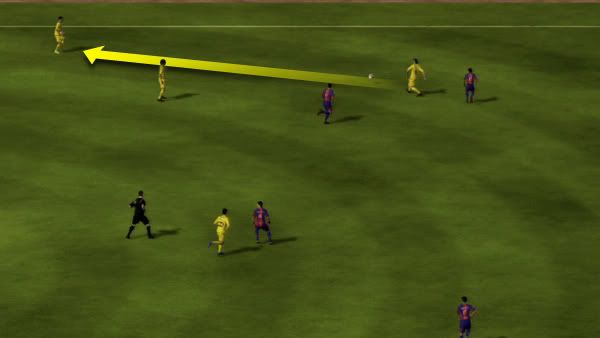 In typical Slow Build fashion, he doesn’t force the issue, but instead lays the ball back so that his team can keep possession. The Slow Build style is often a game of Two Steps Forward, One Step Back.
In typical Slow Build fashion, he doesn’t force the issue, but instead lays the ball back so that his team can keep possession. The Slow Build style is often a game of Two Steps Forward, One Step Back.
 Club Americas has kept possession and now begins to reverse fields to probe the defence with another attack.
Fast Build Up
With Fast Build Up Speed, players will look to quickly release and make more advanced runs. Players will make lots of quick runs and dashes to open space. Use plenty of wall passes and one-touch passes to keep the action flowing quickly. Trap, pass, and move is the name of the game.
Club Americas has kept possession and now begins to reverse fields to probe the defence with another attack.
Fast Build Up
With Fast Build Up Speed, players will look to quickly release and make more advanced runs. Players will make lots of quick runs and dashes to open space. Use plenty of wall passes and one-touch passes to keep the action flowing quickly. Trap, pass, and move is the name of the game.
 We receive the ball in the center circle with our midfielder. We are immediately looking for the next pass to get it going forward.
We receive the ball in the center circle with our midfielder. We are immediately looking for the next pass to get it going forward.
 As soon as we make the pass, we instigate a forward run to hit the open space.
As soon as we make the pass, we instigate a forward run to hit the open space.
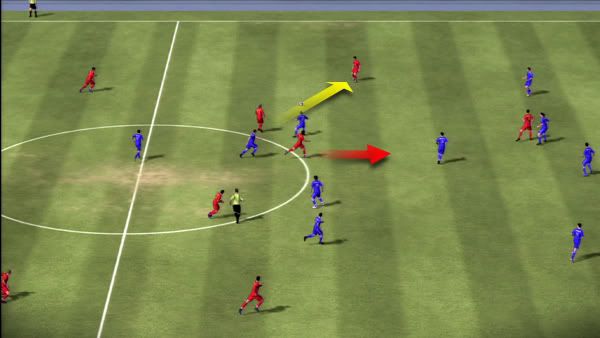 The wing pops open instead, so we fire the ball outside.
The wing pops open instead, so we fire the ball outside.
 Again, we want to keep things moving, so we push the ball ahead to our Striker near the top of the box. You’ll want a big player here who can hold up the ball for the rest of the attackers to come into play.
Again, we want to keep things moving, so we push the ball ahead to our Striker near the top of the box. You’ll want a big player here who can hold up the ball for the rest of the attackers to come into play.
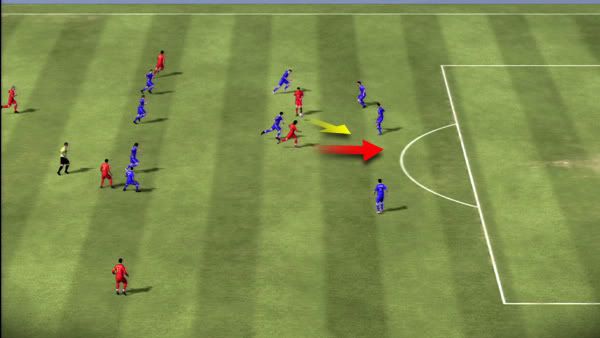 Our initial passer is streaking into the box and will be wide open for a through ball and attempt on goal.
Positioning
Positioning affects the movement of your players in your half of the pitch. With Organized positioning, players will tend to stay more or less in their positional area. With Free Form positioning, you will see players make more flexible runs and take up different positions on the field. This setting does not have as strong an effect on Build Up as it does on Chance Creation.
Putting It All Together
The real fun when working with Custom Tactics comes when you start to combine different Speeds and Passing settings. For example, short passing with Slow build up results in lots of touches by the midfield and defenders, and they knock the ball around to each other in close proximity. Mexican teams like Club America will often use this style of play.
Short passing with a Fast build up speed results in play much like you see with Arsenal and Manchester United. The team uses short passes to keep the ball moving between players, but the pace is pushed to get the ball down the field rapidly.
Slow build up with the long ball may sound like a contradiction. The defence will typically swing the ball around in the back while looking for the big pass. A strong Target man is preferred with these types of teams.
Fast build up with long passing set results in a “hump & chase” style of game. While it’s not very pretty, it can work if you have the right type of personnel. This style can be a great deal of fun to play with.
Our initial passer is streaking into the box and will be wide open for a through ball and attempt on goal.
Positioning
Positioning affects the movement of your players in your half of the pitch. With Organized positioning, players will tend to stay more or less in their positional area. With Free Form positioning, you will see players make more flexible runs and take up different positions on the field. This setting does not have as strong an effect on Build Up as it does on Chance Creation.
Putting It All Together
The real fun when working with Custom Tactics comes when you start to combine different Speeds and Passing settings. For example, short passing with Slow build up results in lots of touches by the midfield and defenders, and they knock the ball around to each other in close proximity. Mexican teams like Club America will often use this style of play.
Short passing with a Fast build up speed results in play much like you see with Arsenal and Manchester United. The team uses short passes to keep the ball moving between players, but the pace is pushed to get the ball down the field rapidly.
Slow build up with the long ball may sound like a contradiction. The defence will typically swing the ball around in the back while looking for the big pass. A strong Target man is preferred with these types of teams.
Fast build up with long passing set results in a “hump & chase” style of game. While it’s not very pretty, it can work if you have the right type of personnel. This style can be a great deal of fun to play with.
 For this example, we have taken control of Celtic, a fast build up, long passing team. Our wing defender gets the ball and immediately hits a 20 yard pass down the wing.
For this example, we have taken control of Celtic, a fast build up, long passing team. Our wing defender gets the ball and immediately hits a 20 yard pass down the wing.
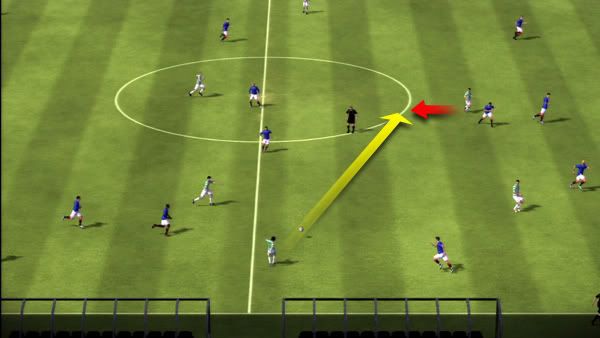 Our winger turns and plays a long ball across the middle. Because we have a Long passing setting, we get check back runs from our strikers.
Our winger turns and plays a long ball across the middle. Because we have a Long passing setting, we get check back runs from our strikers.
 Our striker drops in the hole to collect the ball.
Our striker drops in the hole to collect the ball.
 A quick turn and through pass to the outside keeps things moving.
A quick turn and through pass to the outside keeps things moving.
 We are able to hold off the defender and get our cross in to the striker making the run. He looks offside now, but he was onside when the ball was struck.>
We are able to hold off the defender and get our cross in to the striker making the run. He looks offside now, but he was onside when the ball was struck.>
 Our striker skies from the header as the keeper can only look on in despair.
Chance Creation
Chance Creation relates to how teams perform in the attacking third of the field. It covers what types of passes they will attempt, the frequency of their crosses, how often they like to shoot, and what types of runs they will make. Chance Creation has the most effect on Forwards and Attacking Midfielders. There are four settings for Chance Creation: Passing, Crossing, Shooting, and Positioning.
Our striker skies from the header as the keeper can only look on in despair.
Chance Creation
Chance Creation relates to how teams perform in the attacking third of the field. It covers what types of passes they will attempt, the frequency of their crosses, how often they like to shoot, and what types of runs they will make. Chance Creation has the most effect on Forwards and Attacking Midfielders. There are four settings for Chance Creation: Passing, Crossing, Shooting, and Positioning.
- Passing – Affects the amount of risk the ball possessor takes when making passes in the final third. This also affects the emphasis on forward runs and support runs by teammates of the ball carrier.
- Safe – To maintain possession, the team will rarely try a pass that may risk losing the ball, choosing to wait for the ideal opportunity. Players will ensure that the ball possessor has safe options when positioning themselves, and will wait for a good opportunity to make a penetrating run.
- The team does not look to play particularly safely or riskily.
- Risky – The team will always try for the killer pass. Players look for every opportunity to make runs into space and behind the defence. Teammates won’t be as concerned about ensuring safe options for the ball possessor.
- Crossing – Affects the tendency and frequency for players to put crosses into the box. This also affects the timing of when players make runs into the box, and how many players will look to get into the box to get on the end of a cross.
- Little – The team tries to avoid crossing the ball. Instead, they will try to play out of the crossing zone by passing back, or getting to the end line looking to cut the ball back to a teammate for a shot.
- Normal – The team will put crosses into the box when there is a good opportunity.
- Lots – The team tries to get the ball into the box at every opportunity. The ball possessor will try to cross the ball early. Teammates will make earlier runs into the box.
- Shooting – Chance Creation Shooting affects the amount of shots that the team will take in the final third.
- Little – The team will be patient, and only shoot if the opportunity is extremely good, opting to keep possession. Long shots will be rare.
- The team will perform a variety of long shots and short shots depending on the situation.
- Lots – The team will shoot at every opportunity. Teammates will make the extra effort to position themselves looking for shooting opportunities, for example staying just outside the box looking for a layoff, or positioning themselves for the cutback.
- Positioning – Chance Creation Positioning determines the freedom that players have to make runs, and support in positions in the final third.
- Organized – Players tend not to stray too far from their assigned positions during the course of the match. The team maintains structure when creating chances.
- Free Form – Players have the freedom to make runs out of position. For example, forwards can make runs wide to collect the ball, fullbacks can make more overlapping runs, wide players can cut in more, central midfielders can make runs to the corner or overlap the strikers or wide midfielders.
- How It Works on the Field
Safe vs. Risky Passing
For the CPU, passing will affect both the types of runs and the choices that are made for passes in the attacking third. For your team, the passing setting will determine how your players position themselves. A Safe team concept will provide you with more support. Players will make their runs more to support possession than to create aggressive scoring chances.
A Risky team concept will put a premium on players getting into dangerous space. They will make aggressive runs to try to create chances. The downside is that possession is more difficult to keep. Players aren’t as concerned with helping the man with ball as they are with getting into space. You will need to be very comfortable with the ball at your feet if you are going to use this passing style.
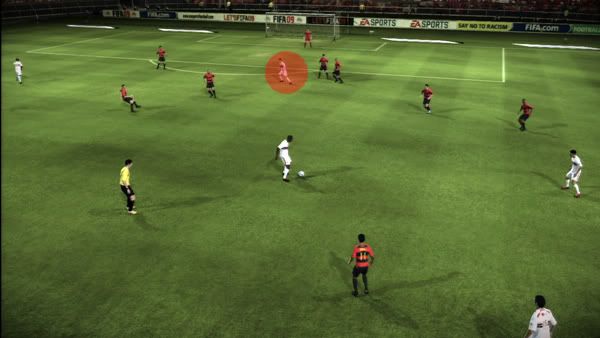 We receive the ball in the center of the field and have a Target man ahead of us. With a Safe passing custom tactic choice, he would check back towards us to receive the ball.
We receive the ball in the center of the field and have a Target man ahead of us. With a Safe passing custom tactic choice, he would check back towards us to receive the ball.
 Instead of a “check to” run, our striker turns to attack the open space near the net. It’s a riskier pass, but if we can complete it we have a good chance to get a look at the goal.
Instead of a “check to” run, our striker turns to attack the open space near the net. It’s a riskier pass, but if we can complete it we have a good chance to get a look at the goal.
 We complete the pass and our Striker has some room in the box to make a turn.
We complete the pass and our Striker has some room in the box to make a turn.
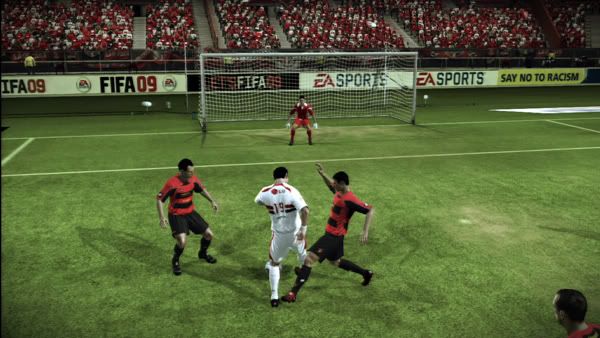 The defence arrives to make a late challenge, but we are able to get the shot off.
The defence arrives to make a late challenge, but we are able to get the shot off.
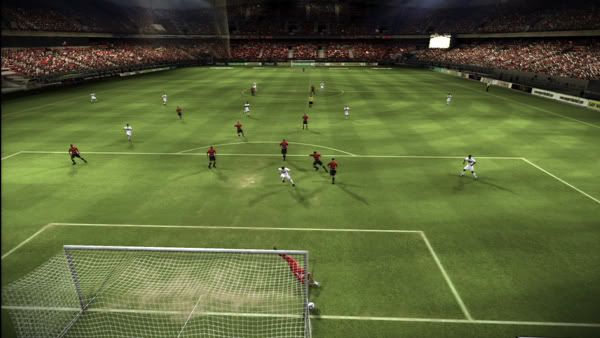 Heartbreak for Sao Paulo as our shot caroms off the post.
Crossing
The Crossing settings refer to the attacking third of play for the most part. CPU teams with Crossing set to Lots will send in more early crosses. Human controlled teams will send more players crashing into the box looking for the cross. You will also see more crossing runs from your strikers and midfielders. Schalke 04 will look to use this style of play as they whip the ball in for 6’3” striker Kevin Kuranyi.
Heartbreak for Sao Paulo as our shot caroms off the post.
Crossing
The Crossing settings refer to the attacking third of play for the most part. CPU teams with Crossing set to Lots will send in more early crosses. Human controlled teams will send more players crashing into the box looking for the cross. You will also see more crossing runs from your strikers and midfielders. Schalke 04 will look to use this style of play as they whip the ball in for 6’3” striker Kevin Kuranyi.
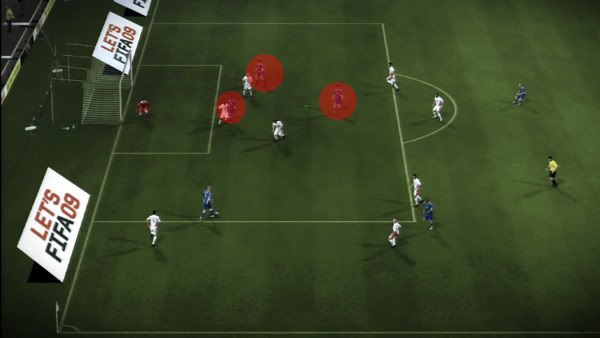 Our winger is able to beat his man and get into a dangerous position just inside the box. Notice that we have three players lined up in case we cross. The near post, back post, and middle of the box are all covered. Since our Crossing slider is set to Lots, our players will work hard to get into position for our service.
Our winger is able to beat his man and get into a dangerous position just inside the box. Notice that we have three players lined up in case we cross. The near post, back post, and middle of the box are all covered. Since our Crossing slider is set to Lots, our players will work hard to get into position for our service.
 We place a great ball across the goal that freezes the keeper on his line.
We place a great ball across the goal that freezes the keeper on his line.
 Our Striker rises on the back post to beat his man and put a head on the ball
Our Striker rises on the back post to beat his man and put a head on the ball
 Goal!!!! A great cross leads to an even better finish for Schalke 04.
The other extreme of the Crossing slide is to set it to Little. When Crossing is set to Little, more players will check wide to receive balls at their feet. You won’t see as many players in the box. They will instead step out and look for one-twos and cut backs. Arsenal is a prime example of a team that uses this style of play. If you have a team with slower wing players, you will definitely want to set your Crossing to Little as well.
Goal!!!! A great cross leads to an even better finish for Schalke 04.
The other extreme of the Crossing slide is to set it to Little. When Crossing is set to Little, more players will check wide to receive balls at their feet. You won’t see as many players in the box. They will instead step out and look for one-twos and cut backs. Arsenal is a prime example of a team that uses this style of play. If you have a team with slower wing players, you will definitely want to set your Crossing to Little as well.
 The Arsenal Midfielder takes the ball down to the far wing. You can see a couple of players in the box, but they will start moving shortly.
The Arsenal Midfielder takes the ball down to the far wing. You can see a couple of players in the box, but they will start moving shortly.
 The winger lays the ball off to the top of the box.
The winger lays the ball off to the top of the box.
 We work the quick passing game inside the box. Our player turns and fires the ball inside to our striker.
We work the quick passing game inside the box. Our player turns and fires the ball inside to our striker.
 We make a quick Cruyff turn, hoping to get a look at the goal.
We make a quick Cruyff turn, hoping to get a look at the goal.
 We experience some heavy contact, but we are able to get the shot away and into the net. Goal for Arsenal!
Shooting
CPU teams with Shooting set on Lots will blast away at the goal any chance that they get. They will take more shots from the top of the box and outside as well. The Shooting setting doesn’t have as great an effect on your team, as you control when you shoot. However, you will see your team try to set up in good shooting positions. They will stake out the top of the penalty area looking for the wingers to penetrate to the end line and cut it back.
We experience some heavy contact, but we are able to get the shot away and into the net. Goal for Arsenal!
Shooting
CPU teams with Shooting set on Lots will blast away at the goal any chance that they get. They will take more shots from the top of the box and outside as well. The Shooting setting doesn’t have as great an effect on your team, as you control when you shoot. However, you will see your team try to set up in good shooting positions. They will stake out the top of the penalty area looking for the wingers to penetrate to the end line and cut it back.
 As our wing player approaches the penalty area, our striker steps to the top of the box and looks for the ball.
As our wing player approaches the penalty area, our striker steps to the top of the box and looks for the ball.
 We reward his movement with a pass to his feet so he can turn to goal.
We reward his movement with a pass to his feet so he can turn to goal.
 The defence is slow to close so we cut it loose on the net.
Positioning
Positioning will have a move dramatic effect on your chance creation in the final third of the pitch. Team set to Free Form will send more Fullbacks on overlapping runs. You will see Wing Midfielders pull in centrally. Your Forwards will make more wide runs and the Central Mids will overlap the strikers with curved runs. Free Form positioning coupled with Crossing set to Little will result in some beautiful chances as players interchange all over the attacking third looking for wall passes and creative throughballs.
The defence is slow to close so we cut it loose on the net.
Positioning
Positioning will have a move dramatic effect on your chance creation in the final third of the pitch. Team set to Free Form will send more Fullbacks on overlapping runs. You will see Wing Midfielders pull in centrally. Your Forwards will make more wide runs and the Central Mids will overlap the strikers with curved runs. Free Form positioning coupled with Crossing set to Little will result in some beautiful chances as players interchange all over the attacking third looking for wall passes and creative throughballs.
 Teams like Barcelona are known for their creative off the ball movement. Anytime they have the ball in the attacking third, the defence had better be prepared for their runs.
Teams like Barcelona are known for their creative off the ball movement. Anytime they have the ball in the attacking third, the defence had better be prepared for their runs.
 Messi vacates his normal wing position and slashes to the top of the penalty area.
Messi vacates his normal wing position and slashes to the top of the penalty area.
 A quick pass catches the defence by surprise and gives Messi room to receive the ball.
A quick pass catches the defence by surprise and gives Messi room to receive the ball.
 Messi has a clear look at the goal, and you know what comes next…he’s going to rip a shot.
Organized positioning will cause players to stay in their area of the field as opposed to running free. They will make a move to space, but their priority is to keep the team’s shape. A team like the Houston Dynamo runs a pretty strict style with safe passing, organized play and lots of crossing. Fuelled by an aggressive pressing, they are able to create scoring chances off of their opponent’s mistakes.
Defence
Manchester United may have the most prolific scorer in the world with Cristiano Ronaldo, but the reason they won the Premiership was their defence. With a league low of 22 goals against, Man U locked it down in the back all season long. While you may not have the same tools in your arsenal, applying the proper Custom Tactics will help you keep the ball out of your own net.
You can adjust where on the field your defence starts to bring pressure, how aggressively they tackle, the width of your defence, and what kind of line they hold in the back.
Messi has a clear look at the goal, and you know what comes next…he’s going to rip a shot.
Organized positioning will cause players to stay in their area of the field as opposed to running free. They will make a move to space, but their priority is to keep the team’s shape. A team like the Houston Dynamo runs a pretty strict style with safe passing, organized play and lots of crossing. Fuelled by an aggressive pressing, they are able to create scoring chances off of their opponent’s mistakes.
Defence
Manchester United may have the most prolific scorer in the world with Cristiano Ronaldo, but the reason they won the Premiership was their defence. With a league low of 22 goals against, Man U locked it down in the back all season long. While you may not have the same tools in your arsenal, applying the proper Custom Tactics will help you keep the ball out of your own net.
You can adjust where on the field your defence starts to bring pressure, how aggressively they tackle, the width of your defence, and what kind of line they hold in the back.
- Pressure – Defensive Pressure determines how high up the pitch the team will start to pressure the opposition.
- Deep – The team drops back and allows the opposition time in their own half in exchange for getting numbers behind the ball.
- Medium – The team will start to defending in their opponent’s half, but not the full length of the pitch.
- High – The team will apply full pressure in their opponent’s half. Wide midfielders and fullbacks will push high on the ball side to make it difficult for the opposition to play out. This tactic is effective but leaves lots of space open for the ball over the top behind the defence.
- Aggression – Defensive Aggression determines how hard the team will tackle and how much pressure is applied to the ball possessor. But be careful, because high aggression can result in a higher number of fouls.
- Contain – The team tries to contain the ball possessor, with players rarely diving into tackles or trying to outnumber the ball carrier.
- Press – The team dives into tackles hard, and will slide whenever possible.
Double – The team will look to tackle fiercely and in numbers, sending an extra player to the ball possessor as often as possible.
- Team Width – Defensive width affects how much the team will shift to the ball side when defending.
- Narrow – The team will defend compactly. Players will pinch in on the far side to cover teammates and allow for ball side pressure. When the ball is central, the team will pack the middle of the pitch and allow more room on the wings.
Normal – The team will not try to defend particularly narrowly or widely.
Wide – The team will not pinch as much. Players on the far side will mark opponent tightly, sacrificing cover in favour of making it difficult for the opposition to pull them out of shape.
- Defender Line – Defender Line affects the shape of your defence, and whether or not they play the offside trap.
- Cover – The players in the back pinch, drop, and cover each other providing depth in defence. This makes through balls more difficult to play, but allows the opposition the freedom to pinch higher.
Offside Trap – The team plays with a flat backline, and looks for the opportunity to step up and catch the opposition offside. The opposition won’t have the freedom of pushing high, but this is a dangerous tactic. When the trap is broken it usually results in an easy scoring opportunity.
How It Works on the Field
Pressure
Pressure determines when the defence starts to pick up the opposing team. With high pressure settings, the defence will begin to pick up their defensive coverage at the opposing team’s 18 yard box. No matter what pressure setting you use, the defence will begin to tighten their coverage as the offense begins to penetrate into the attacking third. The more you press, the quicker your team will become fatigued.
 The defence is operating with a Deep Pressure tactic. With this tactic in place, the defence only brings light pressure on the offence while the ball is not in its half of the field. As the offense crosses the halfway line, the defence will bring to tighten the noose. Against high pressure defences, you will want to keep the ball moving quickly. As defenders try to double, you will find more open players for passers.
The defence is operating with a Deep Pressure tactic. With this tactic in place, the defence only brings light pressure on the offence while the ball is not in its half of the field. As the offense crosses the halfway line, the defence will bring to tighten the noose. Against high pressure defences, you will want to keep the ball moving quickly. As defenders try to double, you will find more open players for passers.
 With the high pressure setting on, the defence begins to attack our ball handlers all the way into our own penalty box. This strategy can create turnovers in dangerous areas of the field, but if the offense breaks the pressure and get the ball down the field, the team can get outnumbered quickly. This style of play does take a toll on your team’s physical condition.
Aggression
The Aggression settings are more CPU related than human related. You alone determine how you defend the dribbler. However, when playing against the CPU, you will see these aggressiveness ratings play out in full effect.
With low aggression settings (Contain), the defenders will contain, jockey, and defend as a team. The distance they keep from their attackers will decrease the closer they get to their own goal.
Middle aggression settings (Press) will cause the defenders to stay a bit tighter to their men, slide tackle more, and take more half chances and stabs at the ball.
High aggression settings (Double) will cause defenders to fly into tackles, stick tight to dribblers, and bring in secondary defenders to press the ball handler.
There is a strong fatigue element to this setting. The more you press and double press, the faster your team will fatigue. They will run out of gas around the 60 minute mark if you lead of the game with heavy pressure. At that point, your players will hit a wall and won’t be able to press anymore.
With the high pressure setting on, the defence begins to attack our ball handlers all the way into our own penalty box. This strategy can create turnovers in dangerous areas of the field, but if the offense breaks the pressure and get the ball down the field, the team can get outnumbered quickly. This style of play does take a toll on your team’s physical condition.
Aggression
The Aggression settings are more CPU related than human related. You alone determine how you defend the dribbler. However, when playing against the CPU, you will see these aggressiveness ratings play out in full effect.
With low aggression settings (Contain), the defenders will contain, jockey, and defend as a team. The distance they keep from their attackers will decrease the closer they get to their own goal.
Middle aggression settings (Press) will cause the defenders to stay a bit tighter to their men, slide tackle more, and take more half chances and stabs at the ball.
High aggression settings (Double) will cause defenders to fly into tackles, stick tight to dribblers, and bring in secondary defenders to press the ball handler.
There is a strong fatigue element to this setting. The more you press and double press, the faster your team will fatigue. They will run out of gas around the 60 minute mark if you lead of the game with heavy pressure. At that point, your players will hit a wall and won’t be able to press anymore.
 The dribbler has the ball in the middle of the field with two defenders in close proximity.
The dribbler has the ball in the middle of the field with two defenders in close proximity.
 As the secondary defender steps up, the rear defender throws himself into the slide tackle.
As the secondary defender steps up, the rear defender throws himself into the slide tackle.
 The attacker is upended, the ball comes loose, and the second defender takes possession. You won’t typically see this hard of a challenge when the attacker is contained unless you are up against a highly aggressive tactic.
Team Width
As mentioned above, Team Width determines how compact or spread out the defensive line plays in the back. It is easier to transition into possession when your backline is compact. On the other hand, it is easier to get the ball out to the wings and move into the attack with a wide setting in the back.
Narrow width settings facilitate opportunities for double teams and secondary pressure. Your team can defend in a zone and collapse on the dribbler. Wide settings put your in more of a man-to-man situation.
The attacker is upended, the ball comes loose, and the second defender takes possession. You won’t typically see this hard of a challenge when the attacker is contained unless you are up against a highly aggressive tactic.
Team Width
As mentioned above, Team Width determines how compact or spread out the defensive line plays in the back. It is easier to transition into possession when your backline is compact. On the other hand, it is easier to get the ball out to the wings and move into the attack with a wide setting in the back.
Narrow width settings facilitate opportunities for double teams and secondary pressure. Your team can defend in a zone and collapse on the dribbler. Wide settings put your in more of a man-to-man situation.
 Celtic is playing a wide defensive line. You will notice that the four defenders are spread out, and the one furthest away from the ball is only shaded slightly inside.
Celtic is playing a wide defensive line. You will notice that the four defenders are spread out, and the one furthest away from the ball is only shaded slightly inside.
 Sporting CP prefers to keep a narrow width. You will see all four defenders collapse together tightly so they can assist each other and double team attacking players.
Defender Line
This last tactic setting is pretty simple as there are only two choices: Cover and Offside Trap. If you are going to run the Offside Trap, you will need to have some serious speed on your defensive line. They will need to have the pace necessary to make up for mistakes and quality runs by the offense. As a general rule, we recommend avoiding the Offside Trap setting as it leaves you too vulnerable to through runs and passes over the top.
Sporting CP prefers to keep a narrow width. You will see all four defenders collapse together tightly so they can assist each other and double team attacking players.
Defender Line
This last tactic setting is pretty simple as there are only two choices: Cover and Offside Trap. If you are going to run the Offside Trap, you will need to have some serious speed on your defensive line. They will need to have the pace necessary to make up for mistakes and quality runs by the offense. As a general rule, we recommend avoiding the Offside Trap setting as it leaves you too vulnerable to through runs and passes over the top.
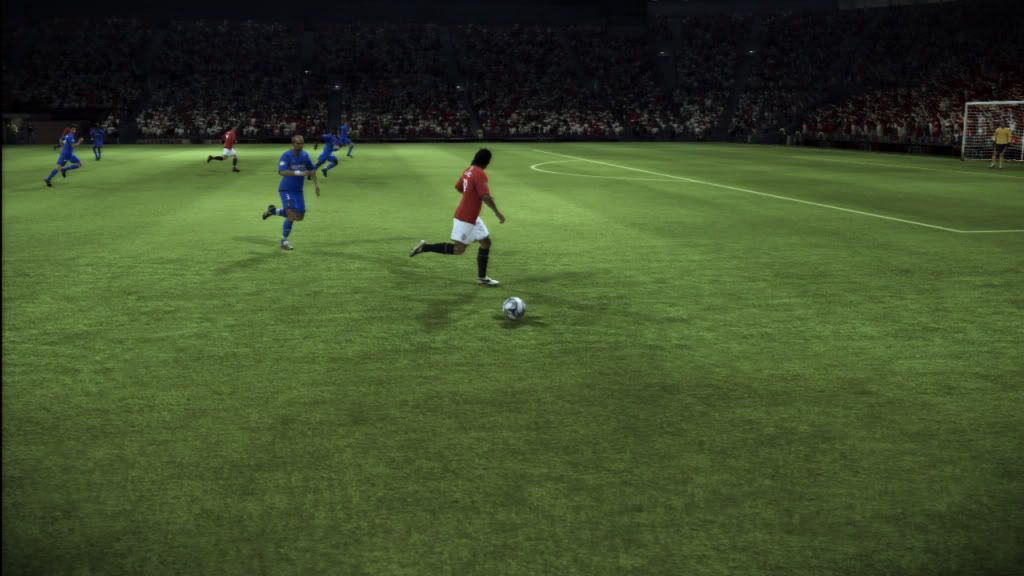 This is the nightmare scenario for a Trapping team. Tevez is going to receive the ball on a full sprint to attack the goal. Notice how the defensive line is stretched across the field. Unless they have serious makeup speed, Tevez is going to notch another goal for Manchester United.
The Cover setting gives you defensive depth. Each defender acts as a sweeper of sorts for the man next to him. This type of defensive line is much tougher to get behind. The Cover also helps with one-on-one situations by giving the defender back up in case he is beaten by his man.
This is the nightmare scenario for a Trapping team. Tevez is going to receive the ball on a full sprint to attack the goal. Notice how the defensive line is stretched across the field. Unless they have serious makeup speed, Tevez is going to notch another goal for Manchester United.
The Cover setting gives you defensive depth. Each defender acts as a sweeper of sorts for the man next to him. This type of defensive line is much tougher to get behind. The Cover also helps with one-on-one situations by giving the defender back up in case he is beaten by his man.
 As the attacker breaks into the center of the defence, you can see Patrice Evra drop back behind the line to prevent the run. This is what the Cover setting is all about. You receive good defensive depth as your backline works together to defend as a unit and protect the dangerous space behind your line.
Teams & Styles
We’ve taken a look at many different teams and tactical scenarios in this section. As we close out our look at Custom Tactics, we want to give you a list of some interesting teams to play with based on their unique styles. If you play through a series of games with each team, you’ll become well versed on how the Custom Tactics feature affects the pace and flow of the game.
Arsenal
Arsenal plays a free-flowing attacking style of offense. They build up quickly with short passes. Once they reach the attacking third, they typically look to play one-two passes in the box instead of crossing. They are frugal with their shot selection, waiting patiently for quality chances on the net. Defensively, they don’t press too hard, but instead wait for the right opportunity to go for the steal and counterattack. Arsenal plays with a 4-4-2 formation.
Chelsea
Chelsea is a bit more patient than Arsenal in their build up. They take their time, but will look for longer passes than any of the other Big 4 English teams. Once in the attacking third, they will look to whip a cross in to players like Didier Drogba. Chelsea will crack a shot from pretty much anywhere with long-range sniper Frank Lampard leading the way. Chelsea doesn’t press defensively, but will go hard into their tackles. Chelsea plays with a 4-3-3 formation.
SydneyFC
Australian club Sydney FC likes to beat you over the top with the long ball. Their strategy is to hold the ball and pass it around in the back while their players make runs down the field. Once they find space, they are going to go Route 1 and make your backline defend all game long. Defensively they are going to press and get in your face to try to take the ball in your end of the pitch. Sydney FC plays a 4-3-3 formation.
Palmeiras
Palmeiras will build up play from the back with extremely short passes. They stay organized and build the attack slowly. Once they get into the attacking third, they flip the switch on their style of play. Palmeiras will begin to look for risky through passes and runs to dangerous space. They don’t cross too often, but aren’t afraid to shoot from just about anywhere on the pitch. They are extremely passive on defence. They will give away ground and keep their line nice and compact. Palmeiras plays a 4-2-2-2 formation.
Bordeaux
plays a quick passing game on offense with its players making plenty of support runs to keep the passes short. They stay organized, but aren’t averse to some risky passes in the attacking third. Where Bordeaux really shows their diversity is on defence. They run an aggressive, pressing defence that keeps plenty of width so they can work the ball out wide and counterattack. Be careful when playing with them as they do run the Offside Trap. Bordeaux plays a 4-2-3-1.
Club America
Club America plays with a fairly typical Mexican league system. They will work the ball slowly and patiently with tons of short passes. They stay organized, play safe passes, and don’t cross the ball often. They will wait for the quality shooting attempt as opposed to firing away. Defensively they will hold deep and not apply pressure until their opponent crosses the halfway line. They will contain and play solid one-on-one defence. Club America plays a 4-2-2-2 formation.
Celtic
Celtic can be a great deal of fun to play with; however, the games often don’t look very pretty. They build quickly, almost at a frenetic pace. They constantly look to make the long pass or through ball. They will stay organized, but look to cross the ball into the area. Celtic will shoot anytime they get a clear look at the net. They play a moderate pressing defence, but hit their tackles pretty hard. Celtic runs a 4-4-2 formation.
Barcelona
Barcelona’s team concept is all about pace. They build up fairly quickly with short passes and lots of creative movement. You can expect to see curved runs and overlaps from penalty area to penalty area. Defensively they press and double while keeping a pretty wide backline. Combined with the Offside Trap, playing with Barcelona can be a scary proposition defensively if you make a mistake, but they are a lot of fun! Barcelona plays a 4-3-3 formation.
As the attacker breaks into the center of the defence, you can see Patrice Evra drop back behind the line to prevent the run. This is what the Cover setting is all about. You receive good defensive depth as your backline works together to defend as a unit and protect the dangerous space behind your line.
Teams & Styles
We’ve taken a look at many different teams and tactical scenarios in this section. As we close out our look at Custom Tactics, we want to give you a list of some interesting teams to play with based on their unique styles. If you play through a series of games with each team, you’ll become well versed on how the Custom Tactics feature affects the pace and flow of the game.
Arsenal
Arsenal plays a free-flowing attacking style of offense. They build up quickly with short passes. Once they reach the attacking third, they typically look to play one-two passes in the box instead of crossing. They are frugal with their shot selection, waiting patiently for quality chances on the net. Defensively, they don’t press too hard, but instead wait for the right opportunity to go for the steal and counterattack. Arsenal plays with a 4-4-2 formation.
Chelsea
Chelsea is a bit more patient than Arsenal in their build up. They take their time, but will look for longer passes than any of the other Big 4 English teams. Once in the attacking third, they will look to whip a cross in to players like Didier Drogba. Chelsea will crack a shot from pretty much anywhere with long-range sniper Frank Lampard leading the way. Chelsea doesn’t press defensively, but will go hard into their tackles. Chelsea plays with a 4-3-3 formation.
SydneyFC
Australian club Sydney FC likes to beat you over the top with the long ball. Their strategy is to hold the ball and pass it around in the back while their players make runs down the field. Once they find space, they are going to go Route 1 and make your backline defend all game long. Defensively they are going to press and get in your face to try to take the ball in your end of the pitch. Sydney FC plays a 4-3-3 formation.
Palmeiras
Palmeiras will build up play from the back with extremely short passes. They stay organized and build the attack slowly. Once they get into the attacking third, they flip the switch on their style of play. Palmeiras will begin to look for risky through passes and runs to dangerous space. They don’t cross too often, but aren’t afraid to shoot from just about anywhere on the pitch. They are extremely passive on defence. They will give away ground and keep their line nice and compact. Palmeiras plays a 4-2-2-2 formation.
Bordeaux
plays a quick passing game on offense with its players making plenty of support runs to keep the passes short. They stay organized, but aren’t averse to some risky passes in the attacking third. Where Bordeaux really shows their diversity is on defence. They run an aggressive, pressing defence that keeps plenty of width so they can work the ball out wide and counterattack. Be careful when playing with them as they do run the Offside Trap. Bordeaux plays a 4-2-3-1.
Club America
Club America plays with a fairly typical Mexican league system. They will work the ball slowly and patiently with tons of short passes. They stay organized, play safe passes, and don’t cross the ball often. They will wait for the quality shooting attempt as opposed to firing away. Defensively they will hold deep and not apply pressure until their opponent crosses the halfway line. They will contain and play solid one-on-one defence. Club America plays a 4-2-2-2 formation.
Celtic
Celtic can be a great deal of fun to play with; however, the games often don’t look very pretty. They build quickly, almost at a frenetic pace. They constantly look to make the long pass or through ball. They will stay organized, but look to cross the ball into the area. Celtic will shoot anytime they get a clear look at the net. They play a moderate pressing defence, but hit their tackles pretty hard. Celtic runs a 4-4-2 formation.
Barcelona
Barcelona’s team concept is all about pace. They build up fairly quickly with short passes and lots of creative movement. You can expect to see curved runs and overlaps from penalty area to penalty area. Defensively they press and double while keeping a pretty wide backline. Combined with the Offside Trap, playing with Barcelona can be a scary proposition defensively if you make a mistake, but they are a lot of fun! Barcelona plays a 4-3-3 formation.
Last edited by BrianFifaFan; 09-25-2008 at 02:00 PM.
|










 Stickied.
Stickied.


















































